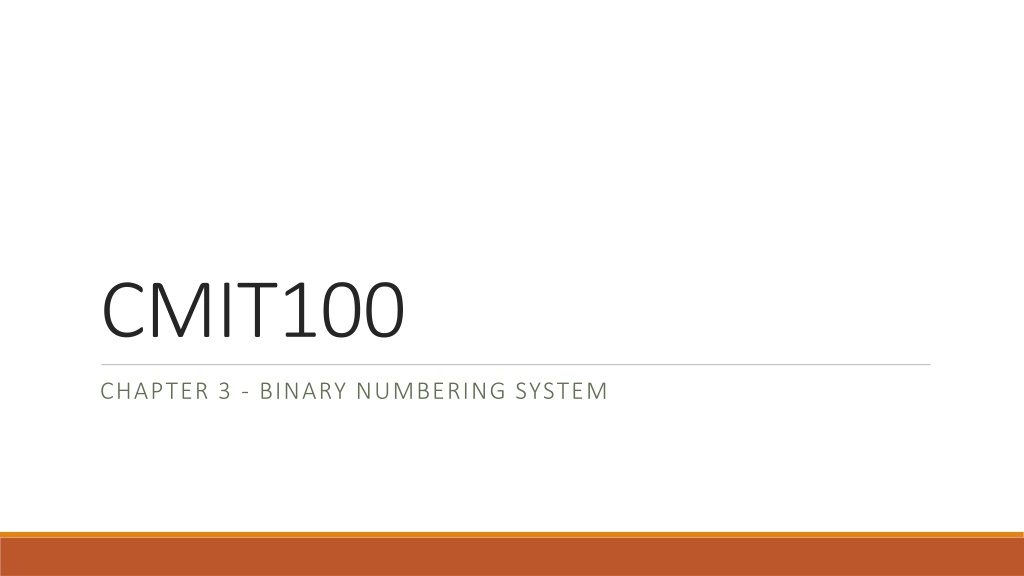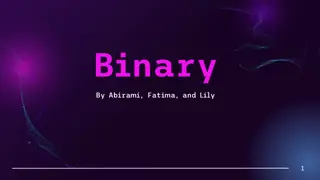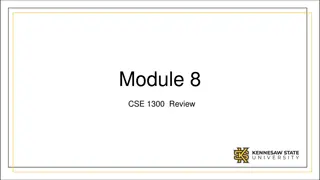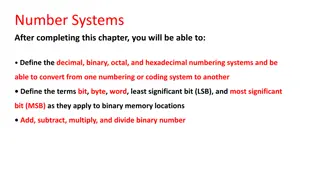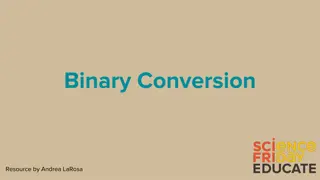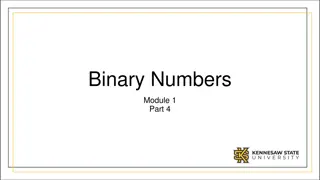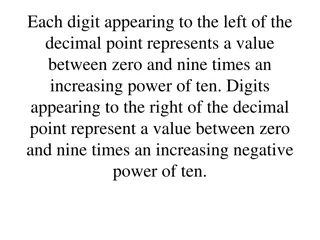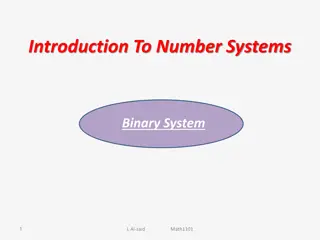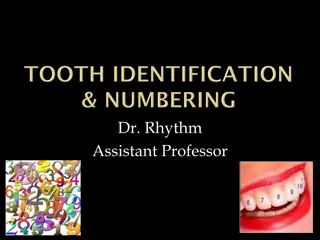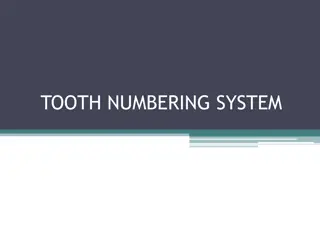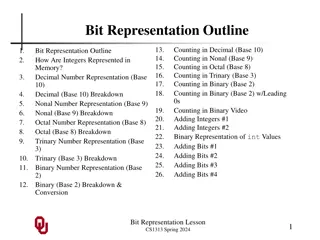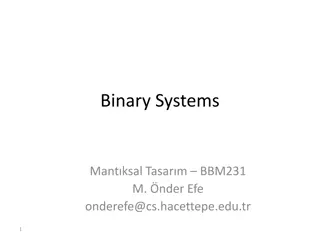Understanding Binary Numbering Systems and Character Representation in Computing
Explore the world of numbering systems including decimal, binary, octal, and hexadecimal, and delve into how characters are stored in computer memory. Learn about Boolean operations and their application on binary numbers, with a focus on IP addresses. Discover the importance of ASCII, Unicode, and the transition to 16-bit characters for international use.
Download Presentation

Please find below an Image/Link to download the presentation.
The content on the website is provided AS IS for your information and personal use only. It may not be sold, licensed, or shared on other websites without obtaining consent from the author. Download presentation by click this link. If you encounter any issues during the download, it is possible that the publisher has removed the file from their server.
E N D
Presentation Transcript
CMIT100 CHAPTER 3 - BINARY NUMBERING SYSTEM
Learning Objectives Describe Numbering Systems: decimal, binary, octal, and hexadecimal. Describe how characters are stored in computer memory. Demonstrate the application of binary (Boolean) operations of AND, OR, NOT, and XOR on binary numbers. Illustrate the use of binary in a computer with a focus on IP addresses.
Numbering Systems Decimal Base 10 Binary Base 2 Octal Base 8 Hexadecimal Base 16
Base 10 System - Decimal Primary human numbering system Digits 0 9 Example: 1, 2, 10, 4,321
Base 2 System - Binary Native numbering system for digital computers Two digits: 0, 1 Each digit is a bit that represents on or off Eight bits is a byte; also known as an octet Example: 0, 1, 10, 101, 1100
Base 8 - Octal Digits 0 7 Examples: 1, 5, 112
Base 16 - Hexadecimal Digits 0 F Examples: 0, 1, 3FA7
Character Representation American Standard Code for Information Interchange (ASCII) Unicode An extension of ASCII EBCDIC - Discontinued
ASCII 7-bit 128 combinations
Extended ASCII 8-bit 256 combinations
Unicode Extended ASCII is not enough for international use One Unicode mapping uses 16 bits per character 65363 Combinations Unicode is a superset of ASCII The first 256 characters correspond exactly to the extended ASCII character set
Binary Operations NOT AND OR NAND NOR XOR Gate - A device that performs a basic operation on electrical signals Circuit - Gates combined to perform more complicated tasks
Binary Operations NOT A NOT gate accepts one input signal (0 or 1) and returns the opposite signal as output
Binary Operations AND An AND gate accepts two input signals If both are 1, the output is 1; otherwise, the output is 0
Binary Operations OR An OR gate accepts two input signals If both are 0, the output is 0; otherwise, the output is 1
Binary Operations NAND The NAND gate accepts two input signals If both are 1, the output is 0; otherwise, the output is 1
Binary Operations NOR The NOR gate accepts two input signals If both are 0, the output is 1; otherwise, the output is 0
Binary Operations XOR An XOR gate accepts two input signals If both are the same, the output is 0; otherwise, the output is 1
Review of Gate Processing A NOT gate inverts its single input An AND gate produces 1 if both input values are 1 An OR gate produces 0 if both input values are 0 An XOR gate produces 0 if input values are the same A NAND gate produces 0 if both inputs are 1 A NOR gate produces a 1 if both inputs are 0
Constructing Gates A transistor has three terminals A source A base An emitter, typically connected to a ground wire
Constructing Gates The easiest gates to create are the NOT, NAND, and NOR gates
Combinational Circuits Gates are combined into circuits by using the output of one gate as the input for another
Creative Commons Statement This work by Southern Maine Community College is licensed under a Creative Commons Attribution 4.0 International License. DOL Statement This workforce product was funded by a grant awarded by the U.S. Department of Labor s Employment and Training Administration. The product was created by the grantee and does not necessarily reflect the official position of the U.S. Department of Labor. The Department of Labor makes no guarantees, warranties, or assurances of any kind, express or implied, with respect to such information, including any information on linked sites and including, but not limited to, accuracy of the information or its completeness, timeliness, usefulness, adequacy, continued availability, or ownership.
